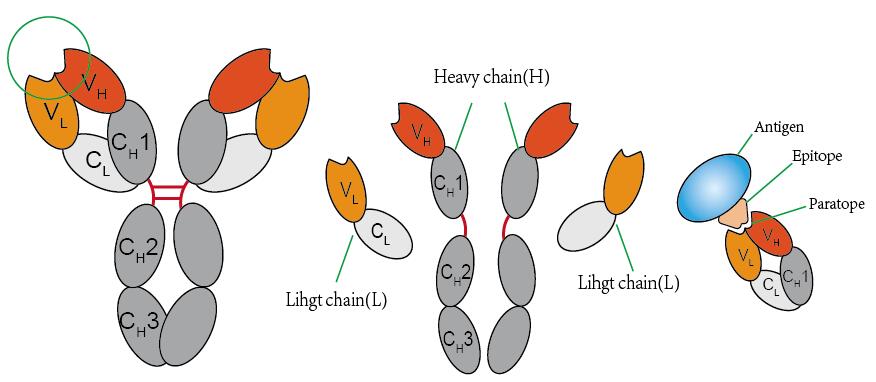G protein-coupled receptor (GPCR) is a very important receptor protein on the cell surface. In the human genome, GPCR-encoding genes account for more than 2% and contain more than 800 members, making them the largest class of cell membrane proteins. According to statistics, 103 GPCRs currently have clinically used drugs for various diseases. And among the drugs currently under development, there are 142 compounds targeting 83 different GPCRs. At present, a large number of G protein-coupled receptor-targeted drugs have been marketed, and a large number of drugs are under development. GPCR is the most valuable target for drug development, and more drugs will be used to treat various diseases in the future.
While the development of small molecule drugs targeting GPCRs, the development of monoclonal antibody drugs has also received great attention. Due to the relatively small extracellular domain of GPCR, complex signal activation, and the relatively large structure of traditional IgG antibodies, it is very difficult to develop. At present, the development of antibody drugs targeting GPCRs is not smooth, and there are only two antibody drugs that have been marketed. Currently, it’s urgent to develop antibody drugs targeting GPCRs in the form of new antibodies.
In 1993, Belgian scientists reported for the first time in the journal Nature that there was an antibody naturally lacking light chains in the peripheral blood of alpacas, and their heavy chain variable regions (VHH regions) were responsible for antigen recognition and binding. More importantly, the independently cloned and expressed VHH structure had the same structural stability and antigen-binding activity as the original heavy-chain antibody. It was the smallest unit known to bind the target antigen, and its molecular weight was only 15kD.
Single domain antibodies have the characteristics of small size, simple structure, stronger tumor tissue penetration ability and easy crossing of the blood-brain barrier, high affinity, low immunogenicity, good hydrophilicity, high stability, and easy modification. It has been widely used in various studies targeting GPCR family members. The development of GPCR research tools and antibody drugs in the form of single domain antibodies is a major trend in the future. Currently, the main applications of single domain antibodies targeting GPCRs include the following:
GPCR structure analysis
The activity state of GPCR is very unstable, which has caused great trouble for the work of structure analysis. In 2011, some scientists published online for the first time that the single domain antibody recognized the activated conformation of β2AR and could stabilize the activated state of the receptor, thus deciphering the structure of β2AR in the active state. This is a milestone work, which not only resolves the structure of GPCR in the active state but also provides a method that single domain antibodies can play a huge role in the analysis of GPCR structure. After that, a series of active states based on single domain antibodies recognizing and stabilizing GPCRs were published online, and the structures of a series of active states of GPCRs were successfully resolved, which greatly promoted the application of single domain antibodies in the field of GPCR research.
GPCR cell imaging
Due to their high affinity and specificity, single domain antibodies are also widely used in GPCR cell imaging, and they also have obvious advantages compared with IgG antibodies. For example, the team of scientists creatively used specific single domain antibodies to cross the blood-brain barrier through intravenous injection of single domain antibodies in the AD transgenic mouse model and observed the pathological processes of AD transgenic mice through in vivo two-photon imaging microscopy. This provides new tools for diagnostic and therapeutic research in the field of neurology.
GPCR activity status detection
In an article published online in 2020 by Bryan L. Roth et al., based on BRET technology, single domain antibodies can be used to detect the activation state of receptors in cells in real time. It mainly used single domain antibodies to specifically recognize the activation/inactivation state of GPCRs, and carried different labels on the receptors and single domain antibodies. The activity state of the receptor was detected in real time according to the change of the BRET ratio before and after drug stimulation.
GPCR endogenous expression and state detection
In 2022, scientists established a new method for detecting the expression and activity of natural membrane protein complexes based on single domain antibodies and found that metabotropic glutamate receptor (mGlu) dimers were highly expressed in brain tissue. Due to their high specificity and affinity, single domain antibodies have unique advantages in detecting the endogenous localization, expression, and aggregation status of GPCRs.
Single domain antibody drug development targeting GPCR
At present, several therapeutic drugs, mainly in the form of single domain antibodies, have been approved for marketing. In addition, in the field of therapeutic research targeting GPCRs, some teams have further reported single domain antibodies that can specifically recognize the activation state of GPCR receptors. In 2017, a research team screened a series of single domain antibodies, which can recognize different conformations of receptors and also has agonist effects and positive allosteric effects. This further shows that single domain antibodies not only play an important role in the analysis of GPCR structure but also have great potential in the development of GPCR drugs.

